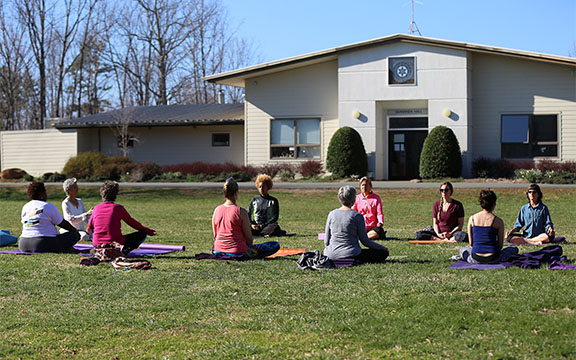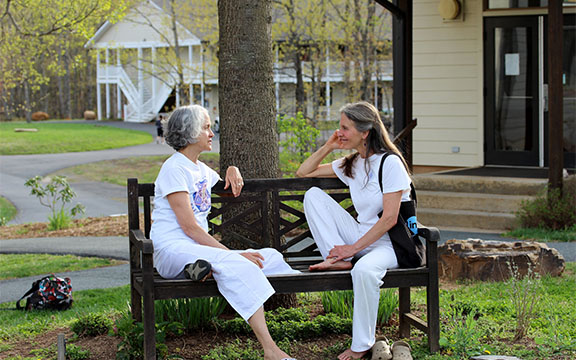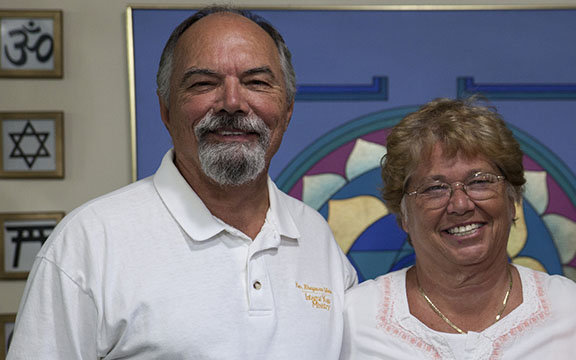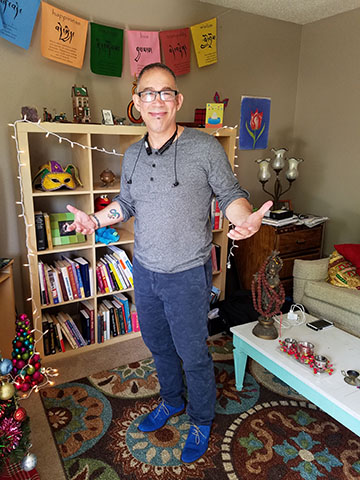
Photo: The “quad” at Satchidananda Ashram–Yogaville.
From 2008 to 2009 I lived at Satchidananda Ashram–Yogaville, in Buckingham County, Virginia. I returned to “the world” in 2009 to take a job in the West Indies, where I spent four clumsy years stumbling all over myself in an effort to integrate the experience and practices of the ashram into “the world.” I returned home to the United States in 2013, settling in Austin, Texas.
The transition and integration process from ashramite to citizen of the world was challenging. I was consumed with anxiety about how to maintain the peaceful consciousness I’d cultivated during a year of rigorous sadhana (spiritual practice, primarily meditation, prayer, veganism, Yoga, and chanting). That’s a common concern as one prepares to leave the safe cocoon of a spiritual community.
If you’ve never lived in such a place, you can’t begin to imagine how healing it is to be greeted by everybody with a bow, hands clasped together in prayer mudra, and the word “Namaste” (“The divine light within me bows before the divine light in you, for they recognize their sameness”). It can change your life: the peaceful mindfulness cultivated by one’s sitting in silence for the first 30 minutes of lunch, surrounded by a panoramic ring of photos of saints from all traditions, photos of Swami Satchidananda everywhere, the chants of Krishna Das reverberating all over the place, and the pervasive, loving serenity that permeates the atmosphere.
At first it all seems weird. After a while, it becomes natural, a healing balm to all one’s broken places. Soon the normal interactions of the mundane world begin to grate on you like nails on a chalkboard. Like most, as I approached my departure date I asked every monk, every sage, and even the occasional saint who passed through there with the question, “How do I maintain this vibration out in the world?” And they all answered with the same message: “Your sadhana will protect you. Wear it like a cloak.”
What I have learned in the seven years since I left the ashram may be more important than anything I learned or experienced while I was living there: The ashram doesn’t end at the ashram. Life after the ashram becomes an extension of the ashram experience, including the relationship with one’s mind, and everything afterward will be flavored by that experience. The good news is that once you’ve lived in a place like that, you never really leave.
Arriving at the Ashram
Before my arrival, my biggest mistake was to think the ashram was going to be a paradise, a heavenly realm, where I could escape the harshness of the world and find inner peace. What really happened was that the conditions were created to make it easier for me to experience my own peace. The place is beautiful and peaceful, yes, but the illusion can persist that the peace has to do with place rather than consciousness. That illusion can generate fear about going back into the world.
When I lived at the ashram, I’d venture most weekends into Charlottesville just to experience a little bit of civilian life. By evening I’d be scurrying back into the peaceful haven of the ashram, glad that I was no longer out there in the world. To an ashramite, the sounds, the pace, and the frantic energy of the world can be irritating. Swami Satchidananda taught that it’s only by immersion in that realm (the world) that one gets to actualize the consciousness of sat chid ananda that’s cultivated within the ashram, but confronting the grating sounds and harshness and rajasic quality of life in the world is enough to make the student mistrust that wisdom.
 I was idealistic to the point of delusion, about my chances of sustaining that consciousness out in the world. I had been meditating for two hours a day, chanting for several hours daily, practicing Yoga, and carrying a gentle mind. As a result, I overestimated the extent of my emotional and spiritual progress and made plenty of lofty statements about “carrying the ashram into the world”—that were more wishful poetry than truth.
I was idealistic to the point of delusion, about my chances of sustaining that consciousness out in the world. I had been meditating for two hours a day, chanting for several hours daily, practicing Yoga, and carrying a gentle mind. As a result, I overestimated the extent of my emotional and spiritual progress and made plenty of lofty statements about “carrying the ashram into the world”—that were more wishful poetry than truth.
Out in the world, the sounds (music), the company (social influences), the diet (from sattvic to rajasic to tamasic), and the lifestyle become a matter of choice rather than structure. All those variables act on the mind and the body, driving an increase of emotional reactivity.
Arriving Back in the World
Almost immediately upon my arriving back in the world, I was greeted with the kind of stares that let me know that people were not seeing “the divine” within me. That lack of respect and acknowledgement, and in some cases fear or even hatred, is the ground from which many people greet one another in the world. I missed the gentle bows and the “Namaste” and felt the sting deep in my soul.
The mourning commenced immediately, and I tried to numb myself. Within a month, I began eating the local cuisine, which consists mostly of chicken and goat. That had a palpable effect on my consciousness. The more meat I ate, the more fear and aggression I felt. My mind went into shock before my body did. I passed through a long period of grieving that had no healthy outlet in a world that didn’t know what it was like to live for an extended time in the loving womb of a spiritual community. Because I relocated to the Caribbean, not a soul could guess I would be suffering. The truth is that there was no beauty that compared to the loving presence emanating from the ashram. We liked to attribute it to Swami Satchidananda, but maybe it was the Guru just waking up within me.
One of the most significant markers of spiritual maturity is the manner in which relationships with friends from the ashram unfold in the diaspora. My strong ties with many people from Yogaville have endured. With some, there’s a lifelong bond that was forged in the fires of that holy place. People whom I haven’t seen in seven years are nestled in a very safe spot in my heart; at any point in our lives we could come to one another and offer sanctuary.
Then there are others with whom I have had conflicts, mostly through social media. While I was living in the ashram it was pretty easy to avoid conflict. I had a few dust-ups— referred to in the ashram as “rubbing and scrubbing” in a nod to Gurudev’s genius use of humor in his teaching. Otherwise, there wasn’t much drama. For the most part, life there is slow, and opportunities to pause and sink into silence are built into its framework. That kind of lifestyle does wonders for one’s temperament and takes the steam out of a good many grudges and resentments. I didn’t make friends with everybody while I lived there, but it’s hard to make enemies in such a place.
Continuing to interact with people in post-ashram life raises additional challenges, however. The rubbing and scrubbing continues, but without the buffer of the daily sadhana. Sometimes the underlying craziness of people rises to the surface out in the real world, and you have to decide how to deal with that. More accurately, my own underlying craziness sometimes drives the bus, and casualties ensue. When I’m eating a tamasic (profane) diet, engaging in “worldly” pleasures, and not attending to my sadhana, the chid ain’t so good. I find myself relating to people mainly through the lens of fear rather than the loving lens of Satchidananda.
A Journey into Hindsight
When I left the ashram, Reverend Vimala Storey, a beloved friend, stored most of my belongings until I returned to the States. The parcel was delivered to me after five years in storage. It was a time machine. I found myself reflecting on some relationships with people whom I once cherished in the ashram but who were no longer in my life. It dawned on me that my ashram life has not ended but has actually continued in the realm of the real world. I was hit with a wave of sadness to think of how I have failed to honor some of the relationships I established in that sacred space. I reviewed my role in those breakdowns. I noticed the difference between the way I related to the world when I lived in the ashram and the way I related to the world once I had left the ashram. Although my life in the ashram was not trouble-free, relatively speaking it was a cakewalk. People were more patient with me there, and I was far more patient with me there. In turn, I was far more patient with others. Having patience with oneself and others is a special form of grace that paves the way to easeful life.
Of the residents, particularly the monks, living there, some were very loving and available for a relationship. Some were emotionally distant, and some clearly didn’t favor me—they’re human, so yeah, they can have dislikes—but I never felt attacked or condemned. As a result, I enjoyed the rare gift of living in a place where there was no violence going on in my own mind—not toward myself, not toward others. That sense of peace is precisely what leads the student to ask, How can I preserve this once I go back out into the world?

Photo: Reverends Bhagavan & Bhavani Metro
Shortly before leaving the ashram, I spent time sitting with Reverend Bhagavan Metro, one of the true sages there and a rock in that community since the early days of Yogaville. He very gently suggested to me that perhaps I could learn to be more tolerant and forgiving of those who offended me. He quoted a teaching given by Sri Swami Sivananda, Swami Satchidananda’s Guru: The highest sadhana is the ability to bear insult and injury without retribution. Though I wasn’t aware at the time, I was quite a distance from that ideal. That became clear within months upon after I’d re-entered the world.
Over the years, little by little, certain relationships have fallen by the wayside as I have reacted to perceived insults. When one is living in a rural spiritual community, each relationship looms a bit larger because one encounters almost every person on a daily basis. Out in the wider world, it’s quite easy to disregard fallen relationships. Once you strike a person off the list, you may never have to see that person’s face again. If a relationship is being carried out primarily through social media, all you have to do is delete the person. But if one looks at life from a broader perspective and sees it as one entity, then all those relationships are revealed as areas within the self that beg for healing. The situation is reduced to exactly what all the sages said to me before I left the ashram: “Wear your spiritual practice like a cloak, and it will protect you.” Indeed.
Where I Am Now
The form of my spiritual practice has taken many twists and turns, crossed many peaks and valleys, and changed many times since I left the ashram. Eventually, I returned to the same sadhana I had enjoyed while living there because a steady spiritual practice involving breath, silence, and the repetition of sacred names is fundamental to my emotional and mental health. My capacity to be of any service in this world depends entirely upon my spiritual practice—just as they said! That is a non-negotiable in my life.
A good gauge of how well that is working is how well I’m able to maintain smooth relations with people, including those I met at the ashram. Bringing graciousness and gracefulness into my relationships is precisely what “bearing insult without retribution” means. That is a mark of a great soul. In my experience, it was easy to feel like a “great soul” when I lived among all those sages and saints, eating my organic vegan food, meditating, chanting, praying, practicing Yoga, and performing service all day long, without really being challenged much. Easy.
If you’re just looking for a break, a little vacation away from the rigors of your mind or your life, then Yogaville is the perfect place to go. If you’re like me, and feel as if your soul had been dragged across a gravel parking lot, life at the ashram can be a healing balm. But if you are a serious seeker and considering spending any length of time there, it may be helpful for you to know that once you’ve been there, you never quite leave. Part one of the ashram is your stay there, and part two is the life you live once you leave. The rules of the game are the same: Get up before sunrise, do your practice, dedicate yourself to service—just as Swami Satchidananda always said.
About the Author:
 Greg Turiya Liotta is a counselor, coach, and facilitator utilizing a synthesis of spirituality, mythology, psychology, and cutting edge research on the mind-body-spirit connection. He combines more than two decades of clinical experience with 30 years as a student of the Mysteries, including 10 years apprenticeship under a Lakota shaman and 10 years as a practicing yogi and teacher of Yoga and meditation. With a background in shamanism, Sufism, Yoga, hermeticism, and metaphysics, Greg helps people integrate all paths in order to cultivate deep spirituality in the practical, day-to-day business of life. Currently he provides Transpersonal Tele-Counseling, coaching and seminars to executives, teams, and leaders all over the world.
Greg Turiya Liotta is a counselor, coach, and facilitator utilizing a synthesis of spirituality, mythology, psychology, and cutting edge research on the mind-body-spirit connection. He combines more than two decades of clinical experience with 30 years as a student of the Mysteries, including 10 years apprenticeship under a Lakota shaman and 10 years as a practicing yogi and teacher of Yoga and meditation. With a background in shamanism, Sufism, Yoga, hermeticism, and metaphysics, Greg helps people integrate all paths in order to cultivate deep spirituality in the practical, day-to-day business of life. Currently he provides Transpersonal Tele-Counseling, coaching and seminars to executives, teams, and leaders all over the world.

